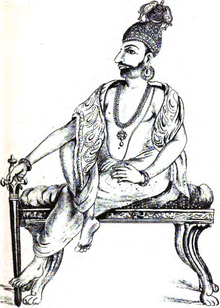Anizham Thirunal Marthanda Varma
| Marthanda Varma മാർത്താണ്ഡ വർമ്മ |
|||||
|---|---|---|---|---|---|
| King of Travancore | |||||

A depiction of Marthanda Varma in A History of Travancore from the Earliest Times (1878) by P Shangunny Menon
|
|||||
| Reign | 1729– 7 July 1758 | ||||
| Predecessor | Rama Varma | ||||
| Successor | Karthika Thirunal Rama Varma ("Dharma Raja") | ||||
| Born | Anizham Thirunal Marthanda Varma 1705 Attingal, Thiruvananthapuram |
||||
| Died | 7 July 1758 (aged 53) Padmanabhapuram, Kanyakumari |
||||
|
|||||
| Father | Raghava Varma, Kilimanur Palace | ||||
| Mother | Karthika Thirunal Uma Devi, Queen of Attingal | ||||
| Religion | Hinduism | ||||
| Regnal name | |
|---|---|
| Sree Padmanabhadasa Vanchipaala Maharajah Sree Anizham Thirunal Veerabaala Marthanda Varma Kulasekhara Perumal |
Marthanda Varma (Anizham Thirunal Marthanda Varma) (1705 – 7 July 1758) was ruler of the southern Indian state of Thiruvithaamkoor (Malayalam: തിരുവിതാംകൂർ Thiruvithaamkoor) from 1729 until his death in 1758. He is most celebrated for crushing the Dutch expansionist designs at the Battle of Colachel in 1741. Marthanda Varma, then adopted a European mode of martial discipline and expanded his domain to encompass what became the modern state of Travancore.
Marthanda Varma built a substantial standing army of about 50,000, reduced the power of the Nair aristocracy (on which rulers of Kerala had earlier been dependent militarily), and fortified the northern limits of his kingdom at the so-called Travancore Lines. His alliance in 1757 with the ruler of Kochi, against Kingdom of Kozhikode, enabled Kochi to survive.
Travancore under Marthanda Varma did make a determined bid to consolidate its power by the use of maritime outlets. At his accession to the throne in early 18th century, the only route remaining was Thiruvithaamkoor to build an elaborate and well-organized war machine while keeping external supply lines open. The control of trade was also seen as crucial in the statecraft of the period. These principles were put into practice by Marthanda Varma.
It was also the policy of Marthanda Varma to extend patronage to the Syrian Christians, a large trading community in Thiruvithaamkoor, as a means of limiting European involvement in trade. The key commodity was pepper, but other goods also came to be defined as Royal Monopoly Items, requiring a license for trade.Thiruvananthapuram (English:Trivandrum) became a prominent city in Kerala under Marthanda Varma. Prime ministers under Marthanda Varma - Arumukham Pillai (1729 – 36), Thanu Pillai (1736 – 37) and Ramayyan Dalawa (1737 – 56) - played a significant role in the raise of the Thiruvithaamkoor state.
Marthanda Varma's policies were continued in large measure by his successor and nephew, Karthika Thirunal Rama Varma ("Dharma Raja") (1758–98), who went on to successfully defend Thiruvithaamkoor against the Kingdom of Mysore.
...
Wikipedia
